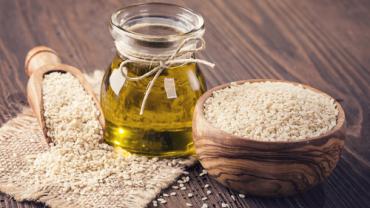
Nuts and seeds wear many hats. First and foremost, they’re delicious. Beyond that, they’re a good source of healthy fats, protein and micronutrients, and they fit into many different dietary paradigms: Paleo, vegetarian, vegan, low carb, ketogenic, and more. Eaten in small amounts, they can even be included in a low fat approach—but good luck keeping it to small amounts. With nuts and seeds, moderation is easier said than done.
For those with the herculean willpower and discipline to consume these foods in moderation, sesame seeds and sesame seed paste (tahini) are a nice way to add some variety to the almonds and walnuts that seem to hog the spotlight with Paleo diets. Many people concerned with optimizing their fatty acid intake may be avoiding sesame due to fears about its omega-6 content, but let’s look at sesame from a broader perspective.
Sesame is the seed of a flowering plant native to India and now cultivated in many areas, including South and Southeast Asia, parts of the Middle East and Africa, and small amounts in South and Central America. The seeds form inside a capsule, which bursts when the seeds are fully ripe. Like sunflower seeds, sesame seeds are valued for their oil content. (Sesame is 40-60% oil.) Sesame oil consists predominantly of monounsaturated and polyunsaturated fatty acids. It contains approximately 40% monounsaturated oleic acid, and about 41% omega-6 linoleic acid. (The remainder is about 14% saturated fats and smaller amounts of other unsaturated fats.) There’s only about 300mg of omega-3 alpha-linolenic acid, giving sesame oil an off-the-charts omega-6 to omega-3 ratio. Many people avoid sesame for this reason, and it’s not unreasonable to do so. But those who enjoy the flavor—particularly the deep, nutty flavor of toasted sesame oil—need not fear including it in their diet from time to time.
According to the late Mary Enig, PhD, author of the book Know Your Fats, and a lipid chemist who was among the first scientists to warn the public about the dangers of trans fats, “Sesame oil has very good oxidative stability, which is thought to be related to sesamin or another unknown antioxidant in the native oil. When sesame oil is added to other oils for use in frying, the oxidative properties of the recipient oil are improved.” (p.122.) Sesame also contains vitamin E, which may help protect against oxidation. And while olive oil is touted as the crown jewel of the Mediterranean diet, healthy populations in the Mediterranean and in North Africa have long enjoyed sesame oil as well. What would a platter of Greek mezze be without hummus made with tahini?
Moving on from the oil, whole sesame seeds are rich in protein and fiber, and offer up impressive amounts of selenium, manganese, copper, magnesium, phosphorus, and zinc, with small amounts of select B vitamins, especially thiamin. They add flavor, texture, and crunch to vegetables and baked goods, and a little goes a long way.
Thanks to creative food bloggers, there are plenty of Paleo-friendly recipes that highlight the special “something” sesame imparts. (Does it matter if sesame oil is “Paleo?”) It’s easy to recreate restaurant favorites, such as honey sesame chicken or sesame shrimp. If you’re gluten or grain-free and miss a bowl of sesame noodles, this recipe for sesame zucchini noodles will be a welcome sight. For lighter fare, consider sesame asparagus salad, or a cucumber sesame salad—great for a summer picnic. And let’s not forget one of the best modifications for those who avoid legumes: cauliflower hummus, which calls for tahini.
But delicious flavor isn’t the only thing sesame has going for it. Despite its high omega-6 content, research suggests it is anti-inflammatory and may reduce atherosclerotic lesions—at least, in mice fed an atherogenic diet. Some of the unique compounds in sesame—such as sesamin—may be responsible for these effects and may explain why an oil that would be assumed to aggravate inflammation actually seems to do the opposite. Both acute and long-term consumption of sesame oil (35 grams/day) improved endothelial function in hypertensive men. The anti-inflammatory properties and antioxidant capacity of sesame oil may also be beneficial for reducing nonalcoholic steatohepatitis and liver fibrosis. Not bad for a food many people eschew on principle. There are some vegetable oils that are best avoided, but perhaps sesame oil doesn’t belong in that category.